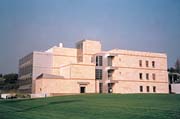
The Broad Center for the Biological Sciences at the California Institute of Technology in Pasadena, CA, was designed to accommodate almost every type of biological research presently done there as well as for future technological advances. Along with laboratories and other specialized science facilities built for this purpose, the 118,000-square-foot building also houses semi-public spaces.
The design architects of Pei Cobb Freed and Partners of New York selected granite and travertine to complement stainless steel panels for the exterior and interior. "We chose stone to make the building compatible with the existing campus buildings, while giving it it's own individual presence," said Mike Flynn, project architect at Pei Cobb Freed.
A total of 21,000 square feet of stone, including travertine cladding for the bulk of the facade, was used for the project. High-honed vein-cut Este Light travertine -- supplied by Mariotti Carli & Figli srl of Italy -- was used for the exterior veneer, columns, interior paving, steps and some walls, while Cold Spring Granite Co. of Cold Spring, MN, supplied Sierra White flame-finished granite for the exterior base of the building.
The installers of DBM/Hatch, Inc. of La Verne, CA, were the single-source subcontractors, responsible for executing all the work on the exterior enclosure of the building. Because the architects requested that no caulking could be seen between the travertine or stainless steel panels, an aluminum liner had to be placed behind the entire exterior facade as the primary line of defense against water penetration. "Open joints were selected for the building to avoid the excessively large sealant joints that would have been necessitated by the building's seismic design criteria," said Flynn.
"The entire project was an open joint system, which means there is no visible sealant," said Tim Hughes of DBM/Hatch, Inc. "We designed a unique blind anchor system, using four aluminum clips, installed in the field by DBM/Hatch setters, and four diocpa insert anchors, installed by Mariotti, into the back of the stone. We used a series of four aluminum clips per stone, which were attached to an aluminum hat channel. We used a hat channel because it was an open joint system and we couldn't drill into the back liner, which was erected and then tested for water infiltration by the CDC, prior to DBM/Hatch installing the facade."
The installation of the exterior stonework took approximately 15 workers three months to complete and was finished in July of 2002. "Open joint is becoming more common in the past three or four years," said Hughes. "It is typically done just so the caulking isn't seen, and it adds a process to the installation, and can complicate things because the backup system has to be completely watertight and be without penetrations from screws."
Though the installation was more challenging than an installation that uses sealant, the installers were experienced with the blind anchor technique and did not face any major difficulties with it. "We had an excellent team of subcontractors, a good anchor and backup system design, with the use of hat channels," said Hughes. "Once the backup system was installed by our subcontractors, the stone installation went very well. The public viewing the facade would generally not realize how much work went into the backup system to achieve the specified open joint system for the stone and stainless steel panels."
Though the building has only been opened recently, the reaction has been positive, according to the installer and architect.

End Box
Broad Center for the Biological Sciences California Institute of Technology Pasadena, CA
Design Architect: Pei Cobb Freed and Partners, New York, NY
Executive Architect: SmithGroup, Santa Monica, CA
General Contractor: Rudolph & Sletten, Irvine, CA
Stone Suppliers: Mariotti Carli & Figli srl, Italy (travertine); Cold Spring Granite Co., Cold Spring, MN (granite)
Stone Installer: DBM/Hatch Inc., La Verne, CA